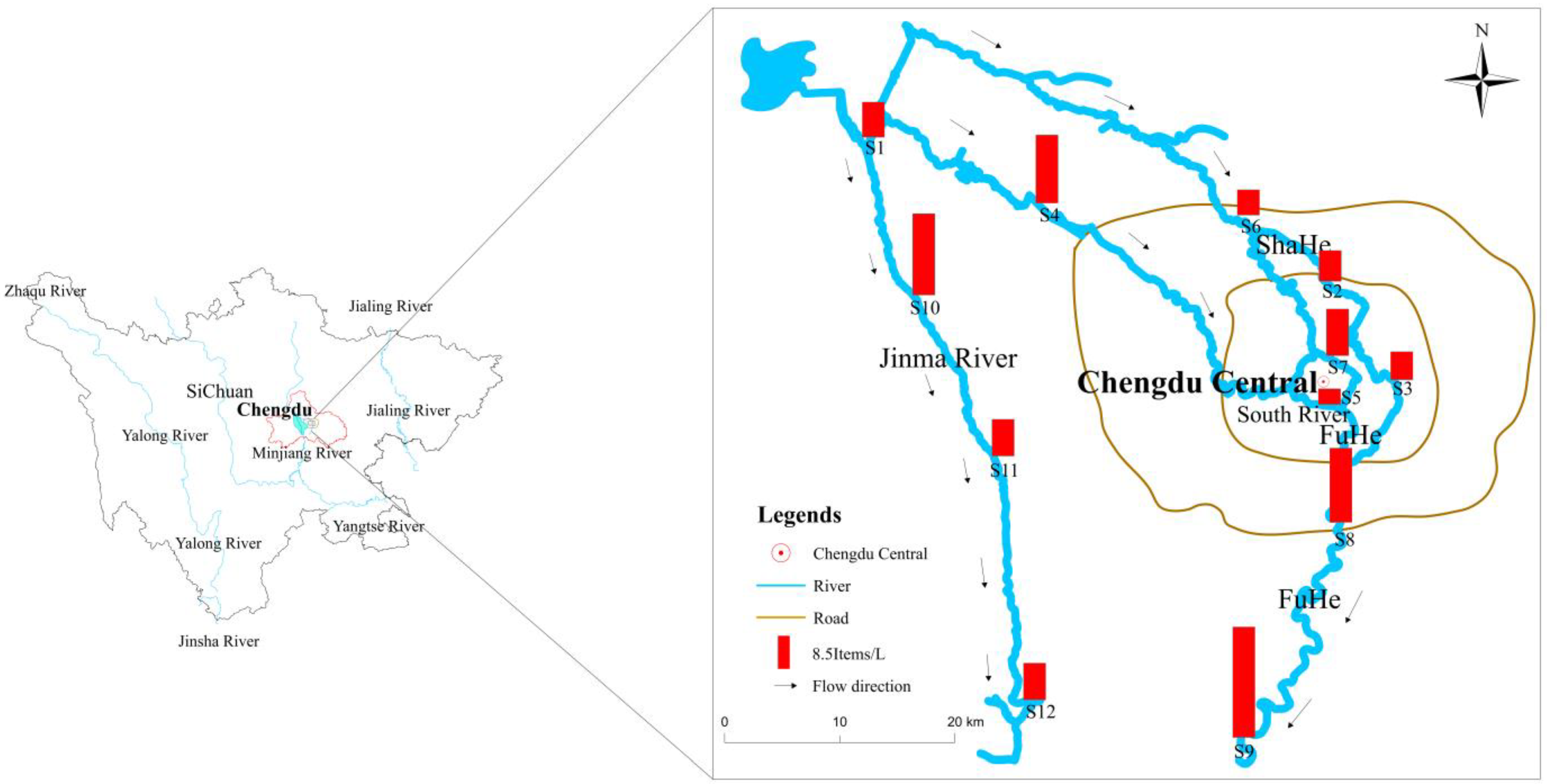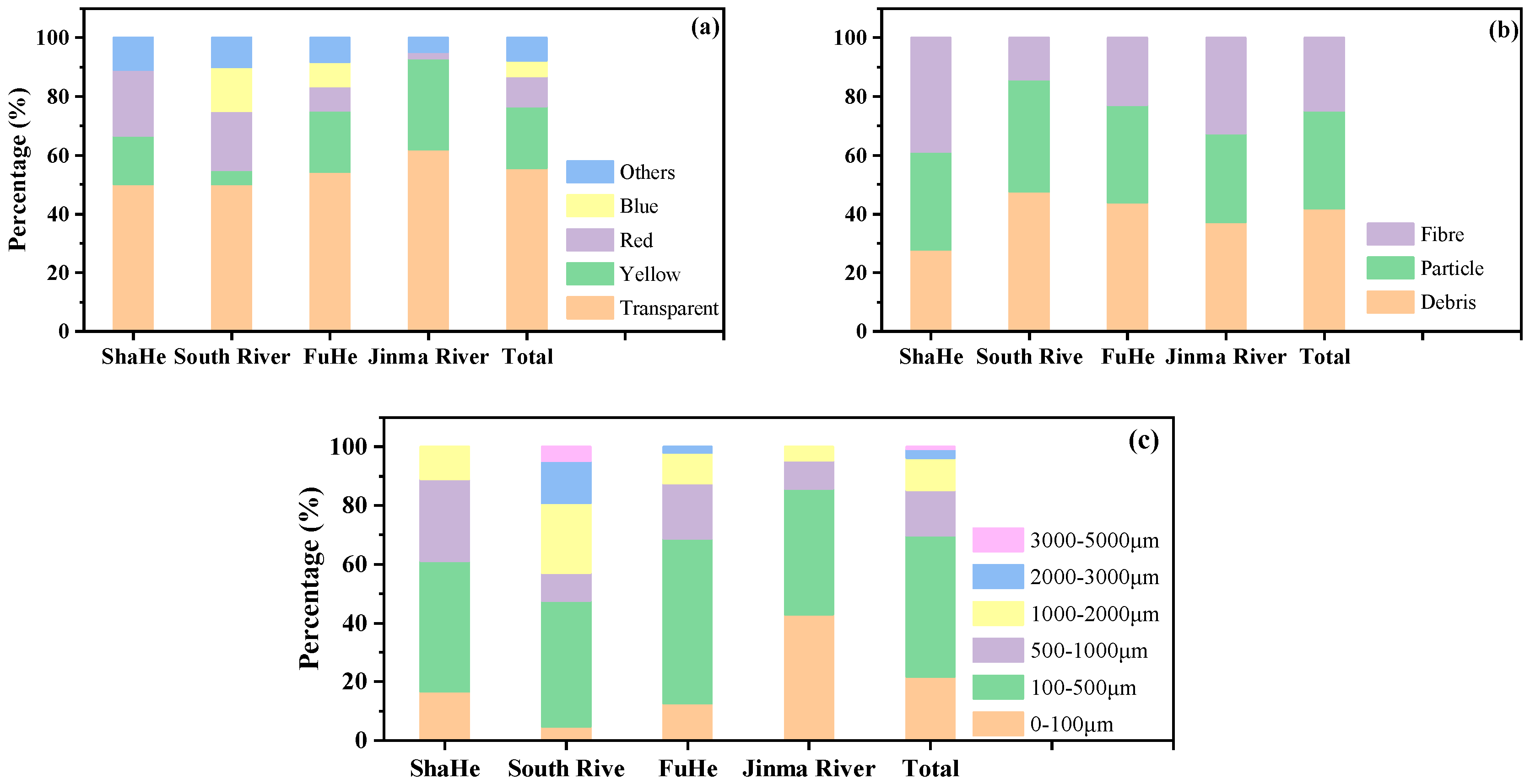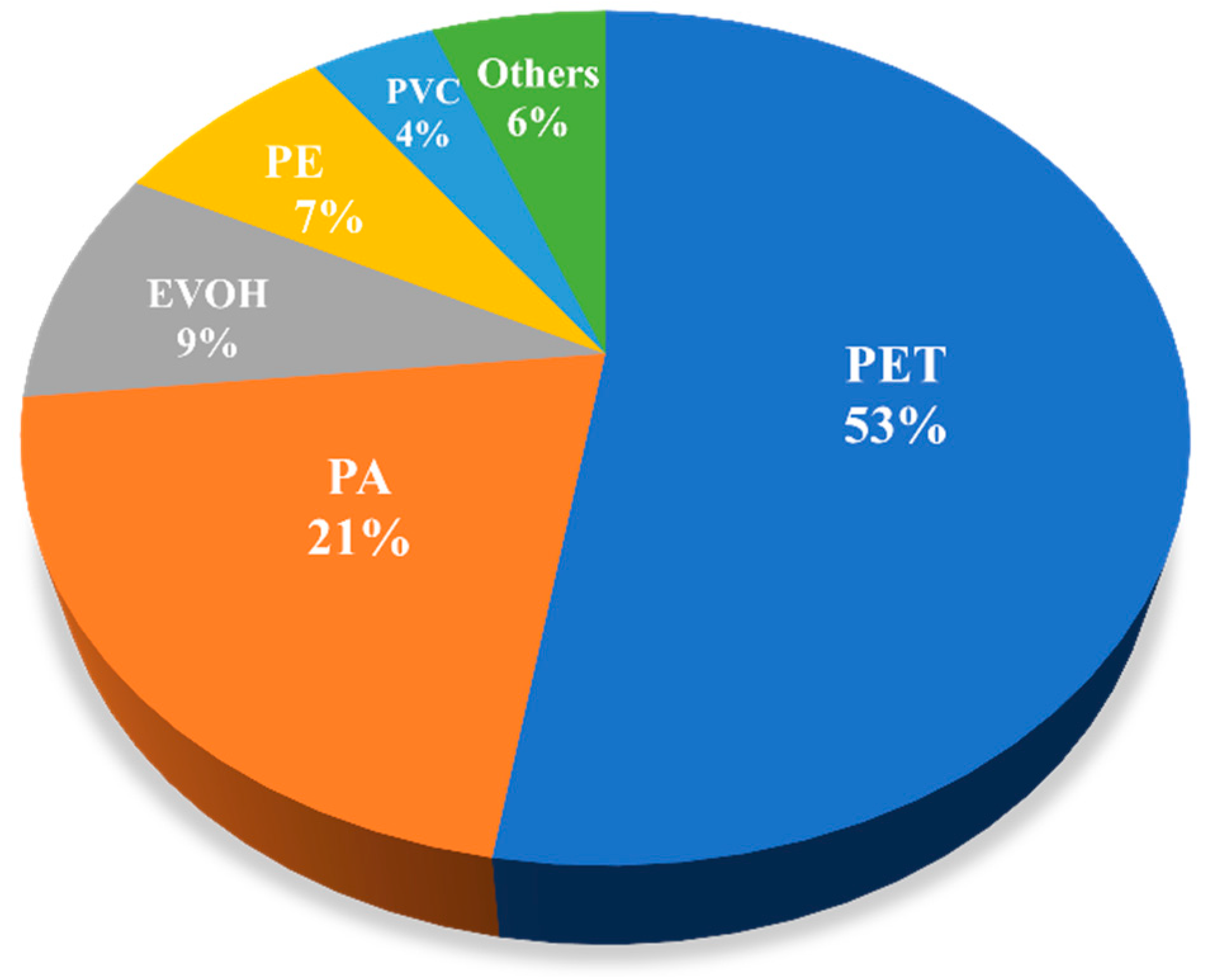Distribution Patterns of Microplastics Pollution in Urban Fresh Waters: A Case Study of Rivers in Chengdu, China
Abstract
:1. Introduction
2. Materials and Methods
2.1. Study Area and Sample Collection
2.2. Laboratory Analysis
3. Results and Discussion
3.1. The Abundance and Distribution of Microplastics
3.2. Morphological Characteristics of Microplastics
3.3. Type Identification of Microplastics
4. Conclusions
- (1)
- The urban rivers in Chengdu contained microplastics, but compared with those of cities in other regions, the content is not high, ranging from medium to low levels. There were many factors affecting the distribution of microplastic particles in water ecological systems, but through comprehensive analyses, we concluded that city population density and regional economic development had a considerable influence on concentration changes. Furthermore, by analyzing the Pearson coefficient correlation of plastic granules quantity with urban population and economic development capacity, the microplastic content in the urban rivers was significantly correlated with the population size, which confirmed our hypotheses. Pollution sources of microplastics in the urban rivers are very complex and difficult to determine. Therefore, phenomena such as municipal pipe network overflow, direct discharge of sewage, and rainwater runoff pollution may critically impact the number of microplastics in rivers.
- (2)
- The forms of microplastics in the studied rivers are mainly debris, particles, and fibers. The microplastics less than 500 μm in size constitute a proportion as high as 69.8%, and most of the microplastics were transparent in color. Small plastic particles are easily eaten by aquatic biota in studied rivers and birds foraging nearby, which may be harmful. Microplastics concentrated in fish and shrimp are transmitted through the food web and may pose a threat to human health.
- (3)
- PET and PA were the main types of microplastics in the rivers, accounting for 52.5% and 20.8% of the total microplastics in all samples, respectively. EVOH, commonly used in food packaging, accounts for 9.12%, and this type of pollution should be monitored.
Author Contributions
Funding
Institutional Review Board Statement
Informed Consent Statement
Data Availability Statement
Acknowledgments
Conflicts of Interest
References
- Cózara, A.; Echevarría, F.; González-Gordilloa, J.I.; Irigoien, X.; Úbeda, B.; Hernández-León, S.; Palma, A.T.; Navarro, S.; García-de-Lomas, J.; Ruiz, A.; et al. Plastic debris in the open ocean. Pans 2018, 28, 10239–10244. [Google Scholar] [CrossRef] [PubMed] [Green Version]
- Thompson, R.C.; Swan, S.H.; Moore, C.J.; vom Saal, F.S. Our plastic age. Philos. Trans. 2009, 364, 1973–1976. [Google Scholar] [CrossRef] [PubMed] [Green Version]
- Plastics Europe. Plastics—The Facts 2019. Available online: https://plasticseurope.org/knowledge-hub/plastics-the-facts-2019/ (accessed on 19 July 2022).
- Geyer, R.; Jambeck, J.R.; Law, K.L. Production, use, and fate of all plastics ever made. Sci. Adv. 2017, 3, e1700782. [Google Scholar] [CrossRef] [PubMed] [Green Version]
- Thompson, R.C.; Olsen, Y.; Mitchell, R.P.; Davis, A.; Rowland, S.J.; John, A.W.; McGonigle, D.; Russell, A.E. Lost at sea: Where is all the plastic? Science 2004, 304, 838. [Google Scholar] [CrossRef] [PubMed]
- Law, K.L.; Thompson, R.C. Microplastic in the seas. Science 2014, 345, 144–145. [Google Scholar] [CrossRef]
- Wu, W.M.; Yang, J.; Criddle, C.S. Microplastics pollution and reduction strategies. Front. Environ. Sci. Eng. 2017, 11, 6. [Google Scholar] [CrossRef]
- Lambert, S.; Sinclair, C.J.; Boxall, A.B. Occurrence, degradation, and effect of polymer-based materials in the environment. Rev. Environ. Contam. Toxicol. 2014, 227, 1–53. [Google Scholar]
- Li, J.N.; Yang, D.Q.; Li, L.; Jabeen, K.; Shi, H.H. Microplastics in commercial bivalves from China. Environ. Pollut. 2015, 207, 190–195. [Google Scholar] [CrossRef]
- Büks, F.; Kaupenjohann, M. Global concentrations of microplastics in soils—A review. Soil 2020, 6, 649–662. [Google Scholar] [CrossRef]
- Miranda, D.A.; Carvalho-Sou, G.F. Are we eating plastic-ingesting fish? Mar. Pollut. Bull. 2016, 103, 109–114. [Google Scholar] [CrossRef]
- Wang, J.D.; Peng, J.P.; Tan, Z.; Gao, Y.F.; Zhan, Z.W.; Chen, Q.Q.; Cai, L.Q. Microplastics in the surface sediments from the Beijiang River littoral zone: Composition, abundance, surface textures and interaction with heavy metals. Chemosphere 2017, 171, 248–258. [Google Scholar] [CrossRef] [PubMed]
- Llorca, M.; Schirinzia, G.; Martínez, M.; Barceló, D.; Farré, M. Adsorption of perfluoroalkyl substances on microplastics under environmental conditions. Environ. Pollut. 2018, 235, 680–691. [Google Scholar] [CrossRef] [PubMed]
- Kwon, J.H.; Chang, S.; Hong, S.H.; Shim, W.J. Microplastics as a vector of hydrophobic contaminants: Importance of hydrophobic additives. Chemosphere 2017, 13, 494–499. [Google Scholar] [CrossRef] [PubMed]
- Moore, C.J.; Lattin, G.L.; Zellers, A.F. Quantity and type of plastic debris flowing from two urban rivers to coastal waters and beaches of Southern California. J. Integr. Coast. Zone Manag. 2011, 11, 65–73. [Google Scholar] [CrossRef]
- Lin, L.; Zuo, L.Z.; Peng, J.P.; Cai, L.Q.; Fok, L.; Yan, Y.; Li, H.X.; Xu, X.R. Occurrence and distribution of microplastics in an urban river: A case study in the Pearl River along Guangzhou City, China. Sci. Total Environ. 2018, 644, 375–381. [Google Scholar] [CrossRef]
- Klein, S.; Worch, E.; Knepper, T.P. Occurrence and Spatial Distribution of Microplastics in River Shore Sediments of the Rhine-Main Area in Germany. Environ. Sci. Technol. 2015, 49, 6070–6076. [Google Scholar] [CrossRef]
- Horton, A.A.; Svendsen, C.; Williams, R.J.; Spurgeon, D.J.; Lahive, E. Large microplastic particles in sediments of tributaries of the River Thames, UK—Abundance, sources and methods for effective quantification. Mar. Pollut. Bull. 2017, 114, 218–226. [Google Scholar] [CrossRef] [Green Version]
- Eriksen, M.; Mason, S.; Wilson, S.; Box, C.; Zellers, A.; Edwards, W.; Farley, H.; Amato, S. Microplastic pollution in the surface waters of the Laurentian Great Lakes. Mar. Pollut. Bull. 2013, 77, 177–182. [Google Scholar] [CrossRef]
- Zhao, S.Y.; Zhu, L.X.; Wang, T.; Li, D.J. Suspended microplastics in the surface water of the Yangtze Estuary System, China: First observations on occurrence, distribution. Mar. Pollut. Bull. 2014, 86, 562–568. [Google Scholar] [CrossRef]
- Lahens, L.; Strady, E.; Kieu-Le, T.C.; Boukerma, K.; Rinnert, E.; Gasperi, J.; Tassin, B. Macroplastic and microplastic contamination assessment of a tropicalriver (Saigon River, Vietnam) transversed by a developing megacity. Environ. Pollut. 2018, 236, 661–671. [Google Scholar] [CrossRef] [Green Version]
- Wang, W.F.; Ndungu, A.W.; Li, Z.; Wang, J. Microplastics pollution in inland freshwaters of China: A case study in urban surface waters of Wuhan, China. Sci. Total Environ. 2017, 575, 1369–1374. [Google Scholar] [CrossRef]
- Battulga, B.; Kawahigashi, M.; Oyuntsetseg, B. Distribution and composition of plastic debris along the river shore in the Selenga River basin in Mongolia. Environ. Sci. Pollut. Res. 2019, 26, 14059–14072. [Google Scholar] [CrossRef] [PubMed]
- The Opinions on Further Strengthening the Control of Plastic Pollution. Available online: http://www.gov.cn/zhengce/zhengceku/2020-01/20/content_5470895.htm (accessed on 19 July 2022). (In Chinese)
- Nuelle, M.T.; Dekiff, J.H.; Remy, D.; Friesa, E. A new analytical approach for monitoring microplastics in marine sediments. Environ. Pollut. 2014, 184, 161–169. [Google Scholar] [CrossRef] [PubMed]
- Shim, W.J.; Hong, S.H.; Eo, S.E. Identification methods in microplastic analysis: A review. Anal. Methods 2017, 9, 1384–1391. [Google Scholar] [CrossRef]
- Su, L.; Xue, Y.G.; Li, L.Y.; Yang, D.Q.; Kolandhasamy, P.; Li, D.J.; Shi, H.H. Microplastics in Taihu Lake, China. Environ. Pollut. 2016, 216, 711–719. [Google Scholar] [CrossRef]
- Ballent, A.; Purser, A.; de Jesus Mendes, P.; Pando, S.; Thomsen, L. Physical Transport Properties of MarineMicroplastic Pollution. Biogeosci. Discuss. 2012, 9, 18755–18798. [Google Scholar]
- Wang, J.D.; Tan, Z.; Peng, J.P.; Qiu, Q.X.; Li, M.M. The behaviors of microplastics in the marine environment. Mar. Environ. Res. 2016, 113, 7–17. [Google Scholar] [CrossRef]
- Chengdu Bureau of Statistics. Chengdu 7th National Census Bulletin (No. 7). Available online: http://www.cdstats.chengdu.gov.cn/htm/detail_385085.html (accessed on 19 July 2022). (In Chinese)
- Chengdu Bureau of Statistics. Economic Operation of Chengdu in the First Half of 2021. Available online: http://www.cdstats.chengdu.gov.cn/htm/detail_396051.html (accessed on 19 July 2022). (In Chinese)
- Sina.com. GDP Ranking in the First Half of 2021, Chengdu, the Strength of Cities and Counties Reshuffle? Available online: http://k.sina.com.cn/article_5882979292_15ea723dc02700v22e.html (accessed on 19 July 2022). (In Chinese).
- Su, L.; Sharp, S.M.; Pettigrove, V.J.; Craig, N.J.; Nan, B.; Du, F.; Shi, H.H. Superimposed microplastic pollution in a coastal metropolis. Water Res. 2020, 168, 115140. [Google Scholar] [CrossRef]
- Wang, C.H.; Zhao, J.; Xing, B.S. Environmental source, fate, and toxicity of microplastics. J. Hazard. Mater. 2021, 407, 124357. [Google Scholar] [CrossRef]





| No. | Location | Size Class (mm) | Mean Concentration of Microplastic, Items/L | Dominant Microplastic | Reference |
|---|---|---|---|---|---|
| 1 | Los Angeles River, USA | 1~4.5 | 12.9 | -- | [15] |
| 2 | San Gabriel River, USA | 1~4.5 | 0.41 | -- | [15] |
| 3 | Pearl River, China | 0. 02~5 | 0.38~7.92 | PE, PP | [16] |
| 4 | Saigon River, Vietnam | 0.2~1 | 172 ± 519 | -- | [21] |
| 5 | urban surface waters of Wuhan, China | 0.05~5 | 0.921~10.516 | PET, PP | [22] |
| 6 | Taihu Lake, China | 0.3~5 | 3.4~25.8 | PE | [27] |
| 7 | urban rivers in Chengdu, China | 0. 02~5 | 5.00~10.5 | PET, PA | This study |
| Item | Concentration, Items/L | Population, Million | GDP, Billion |
|---|---|---|---|
| Shahe | 5 | 264.73 | 162.8 |
| South river | 7.5 | 265.38 | 146.3 |
| Jinma river | 9.83 | 277.73 | 101.4 |
| Fuhe | 10.5 | 702.47 | 351.1 |
| Pearson coefficient | 1 | 0.98 * | 0.5 |
Publisher’s Note: MDPI stays neutral with regard to jurisdictional claims in published maps and institutional affiliations. |
© 2022 by the authors. Licensee MDPI, Basel, Switzerland. This article is an open access article distributed under the terms and conditions of the Creative Commons Attribution (CC BY) license (https://creativecommons.org/licenses/by/4.0/).
Share and Cite
Chen, J.; Deng, Y.; Chen, Y.; Peng, X.; Qin, H.; Wang, T.; Zhao, C. Distribution Patterns of Microplastics Pollution in Urban Fresh Waters: A Case Study of Rivers in Chengdu, China. Int. J. Environ. Res. Public Health 2022, 19, 8972. https://doi.org/10.3390/ijerph19158972
Chen J, Deng Y, Chen Y, Peng X, Qin H, Wang T, Zhao C. Distribution Patterns of Microplastics Pollution in Urban Fresh Waters: A Case Study of Rivers in Chengdu, China. International Journal of Environmental Research and Public Health. 2022; 19(15):8972. https://doi.org/10.3390/ijerph19158972
Chicago/Turabian StyleChen, Juan, Yinger Deng, Yong Chen, Xin Peng, Han Qin, Tao Wang, and Chenchen Zhao. 2022. "Distribution Patterns of Microplastics Pollution in Urban Fresh Waters: A Case Study of Rivers in Chengdu, China" International Journal of Environmental Research and Public Health 19, no. 15: 8972. https://doi.org/10.3390/ijerph19158972
APA StyleChen, J., Deng, Y., Chen, Y., Peng, X., Qin, H., Wang, T., & Zhao, C. (2022). Distribution Patterns of Microplastics Pollution in Urban Fresh Waters: A Case Study of Rivers in Chengdu, China. International Journal of Environmental Research and Public Health, 19(15), 8972. https://doi.org/10.3390/ijerph19158972





